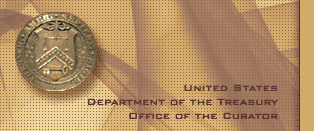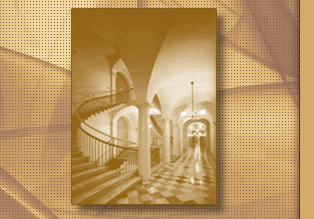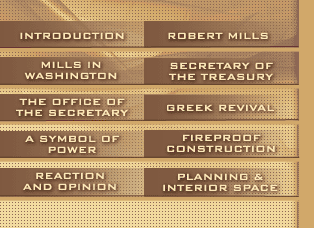“..in
the Treasury Building---[Mills’] repeated, individually
vaulted cells, articulated access to every office, and
a narrow, dark, barrel-vaulted corridors for access.
In forming the Treasury Building on the vast scale he
did, however, Mills recast these elements into a new
imagery and a new conception of the bureaucratic work
space.”
~Dell Upton, Architectural Historian,
1996
The architectural importance of
the East wing goes beyond style and aesthetics. Mills’
approach for the interior of the E-shaped plan reflects
the building’s function as a modern office building
comprised of long expanses of double-loaded corridors
of office spaces, an entirely new concept in America.
These repetitive cells represent a modular system of
spatial division where each office is of nearly equal
size formed by the module of the vaulting system that
served a duel function with the fireproof construction.
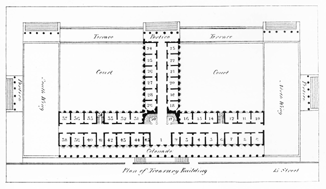
Mills’ design for a floor plan,
shown above, illustrates the modular spatial planning
for the offices, a new concept that gave rise to the
office building. Mills began by constructing the East
wing (including the center projection), his long-term
vision included two additional projecting wings toward
the White House which would be joined by a terrace
along the West side, seen at the top of the plan.
Click
here to see a larger image
Shortly after the building was completed,
the expanding Treasury Department quickly exceeded the
available office space, leading to increasingly overcrowded
offices and corridors congested with clerical desks,
files, and stored materials. Consequently, thirteen
years after the original Treasury was completed, designs
were produced to expand the space with the South wing
addition in 1855. Adding on to Mills’ Treasury
was a relatively easy design task given the repetitious
arrangement of the modular office spaces
The interiors of Mills’ East wings are distinguished
from the South, West, and North additions by the unbroken
barrel-vaulted corridors and groin-vaulted offices that
carry out the mandate for fireproof masonry construction.
Advances in cast iron construction made fully masonry-vaulted
construction unnecessary in Treasury’s successive
wings.
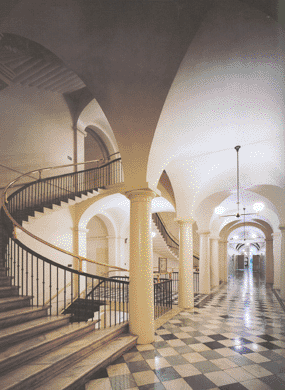
Photo by Robert C. Lautman
Click
here to see a larger image
The simple Doric columns, seen above,
along with the plain balustrade of the cantilevered
staircase create an aesthetic palette that is more restrained
than the rest of the Treasury. The fluted columns and
pilasters crowned with elaborate capitals that were
used in the later additions reflect a change in fashion
in the mid-1800’s.
Although sandwiched between the North and South
wing porticos at either end of the 15th Street façade,
Mills’ original colonnade may still be seen in
its entirety. However, significant changes to the exterior
have altered the way the interior is used. In 1910,
the exterior steps to the second floor that formed the
original 15th Street entrance were removed following
a re-grading of 15th Street. This changed Treasury’s
entry to the first floor, resulting in a less formal,
darker vestibule than was intended by Mills.
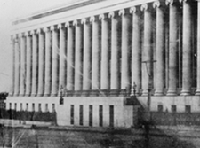
Click
here to see a larger image
The photograph above, taken
in 1856, shows the original projecting entry stair
to the second floor of the East wing while the image
below shows the lowered entrance onto the first floor
as it appears today.
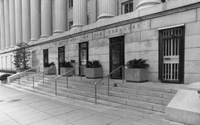
Interested in this topic?
More detailed research is available here
|
